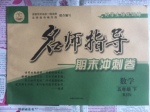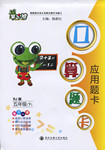题目内容
In the 1990s.a trip to Zhangjiajie cost less than 500 yuan,but now with the same amount of money you even cover the entrance fee.
A.couldn’t B shall’t C.can’t D.won’t
C
解析:
“Can”is used for saying that the situation:makes it possible for you to do something at a particular time.情态动词can表示“某时的条件使人可以做某事”,意思是:能;A项couldn’t是can’t的过去式。

 名师指导期末冲刺卷系列答案
名师指导期末冲刺卷系列答案 开心蛙口算题卡系列答案
开心蛙口算题卡系列答案People
People is America’s No.1 magazine about fascinating(迷人的)people. It’s a guide to who and what’s hot in the arts, science, business, politics, television, movies, books, music and sports. It is published weekly.
Publisher: The Time Inc. Magazine Company
Cover Price: $211.47
Our Price:$117.00
Issues(期数):53 issues/ 12 months
Lucky
Lucky is the shopping magazine with the best buys(合算的商品), and the fashion tips you’ll need before you hit the stores. What makes Lucky really special is that it gets you the information you need before anyone else has it.
Publisher: Conde Nast Publications Inc.
Cover Price: $35.40
Our Price:$15.00
Issues(期数):12 issues/ 12 months
Parents
The most trusted magazine for parents who want to raise smart, loving and self-confident children. Each issue has age-specific child-development guidance, advice on your child’s health and safety, and the best ways to encourage your child’s learning.
Publisher: Meredith Corporation
Cover Price: $42.00
Our Price:$9.97
Issues(期数):12 issues/ 12 months
Entertainment
This magazine covers movies, television, music, Broadway stage productions, books, and popular culture. Unlike celebrity-focused magazines like People, its main concentration is on entertainment media and reviews. It’s intended for a more general audience.
Publisher: The Time Inc. Magazine Company
Cover Price: $199.50
Our Price:$38.95
Issues(期数):57 issues/ 12 months
【小题1】 Which of the following is for common readers?
| A.Lucky. | B.Parents | C.Entertainment. | D.People. |
| A.It has lots of cartoons. | B.It has pictures of stars. |
| C.It tells you where to find bargains. | D.It has information no one else has. |
| A.hot events and famous stars | B.festivals and celebrations |
| C.political events | D.daily life |
| A.on a magazine club website | B.in an educational magazine |
| C.in a guide to magazines | D.in a magazine sales report |
| A.Lucky. | B.Parents | C.Entertainment. | D.People. |
Ice Hotel Quebec, located 30 minutes west of Downtown Quebec City, Canada, is only open during the winter season. The hotel is made entirely of ice. The two galleries at the Ice Hotel Quebec feature events such as ice painting and ice sculpture(冰雕) competitions.
Things to Do
Guests have a choice of different winter vacation activities, including cross-country skiing, ice skating, dog sledding (狗拉雪橇), ice fishing and sliding(滑行). Ice Hotel Quebec has a sauna( 桑拿浴),so remember to pack your bathing suit.
Rooms & Suites(套房)
The hotel offers 18 rooms and 14 theme suites built from 12,000 tons of snow and 400 tons of ice. The walls at Ice Hotel Quebec are four feet thick and allow the hotel to keep a temperature of -2℃ to -5℃.
The furniture at the hotel is made of snow and ice, including the beds. The beds are equipped with a thick foam mattress(泡沫床垫)and an extra thick sleeping bag. That is enough to prevent you from catching a cold.
Vacation Tip
Ice Hotel Quebec offers 30-minute guided public tours daily from 10:30am to 4:30pm. It costs $15 CAD for adults, $7.5 for children (under eight), $13for students\seniors (above sixty), and $42 for families.
Plan This Vacation
Ice Hotel Quebec-Canada will be open for its sixth season from January 5th to April 1st. Costs for overnight stays start at $199CAD per person.
If you’re looking for something really different to do on your next trip, think creatively and plan to visit the truly unusual Ice Hotel Quebec!
【小题1】If you visit the Ice Hotel, you can enjoy the following EXCEPT___________.
| A.going fishing |
| B.going skating |
| C.appreciating ice sculptures |
| D.holding an ice party |
| A.the rooms are made of ice |
| B.the temperature is as high as -2℃ |
| C.the sleeping bags are warm |
| D.the walls are four feet thick |
| A.$37.5 CAD | B.$45 CAD | C.$42CAD | D.$199 CAD |
下面文章中有5处需要添加小标题。请从以下选项( A、B、 C、D、E和F)中选出符合各段意思的小标题,并在答题纸上将相应选项的标号涂黑。选项中有一项是多余选项。
| A. Find a fiction book. B. Learn how to read your card. C. Find your non-fiction book. D. Decide if you want to search by author, title or subject. E. Learn to find the card you need. F. Understand the Dewey Decimal System. |
The card catalog was once found in every library. Most libraries have now replaced the card catalog with a computerized cataloging system. However, some libraries still have the set of drawers with thousands of cards inside, and some library patrons still prefer the hands-on approach to researching the information they need. Cards are set up alphabetically in long drawers. Different types of cards are kept separate from each other so you may search by author, title or subject. Learning to use the card catalog can help you find the book you want without waiting for a computer terminal.
Instructions:
1______
Once you have found the card for the book you want, write down the numbers and letters at the top of the card and the title and author of the book. The numbers at the top are how the book is cataloged using the Dewey Decimal System, and the letters are the first three letters of the author's last name. Your library will have the numbers at the end of the stacks (the shelves of books), so find the stack your book is located in, then scan the shelves of that stack until you locate the number on the card. More than one book can have the same number, so you will narrow down your search if you have the first three letters of the author's name.
2______
The cards in a card catalog reference other cards. An author card will also have a book title and subject, a title card will have the author and subject, and a subject card will have author and title. This is handy for cross-referencing, so if you want to read a book on beekeeping, you can look that up in the subject cards and find an individual card on each book the library carries on beekeeping.
3______
If you want to look up a book by Stephen King, find the author cards in your library's card catalog, and look under "K". The cards are organized by last name and are broken down into the individual drawers. Sometimes a letter will take up more than one drawer, so you may find drawers that have "Ka-Ke" and then "Ki-Kr." Stephen King will be in the drawer with "Ki-Kr." You would find a card in a similar manner by title or by subject by finding the drawer with the corresponding letters such as "Be" for beekeeping in the subject cards or "Wr" for "The Writer's Market" ("The" is not considered part of titles).
4______
This isn't required to use the card catalog, but it can make searching for your book a little easier. The numbers range from 000 to 999; 000-099 are general subjects, 100-199 are psychology and philosophy, 200-299 is religion, 300-399 is social science, 400-499 is language, 500-599 are natural science and math, 600-699 is applied sciences, 700-799 is art, 800-899 are literature and plays, and 900-999 are geography and history.
5______
The author card will have a call number at the top, a line with the author's name with last name first, then lines for the title of the book, its publisher, a brief summary and subject listings. For an author with many books like Stephen King, there will be a card for each of his books in alphabetical order. Title cards are similar but have the title first, then the author in the following line. Subject cards have the subject in all capital letters at the very top of the card and the same information as on an author's card. Many cards on the same subject will be organized by the authors' last names.